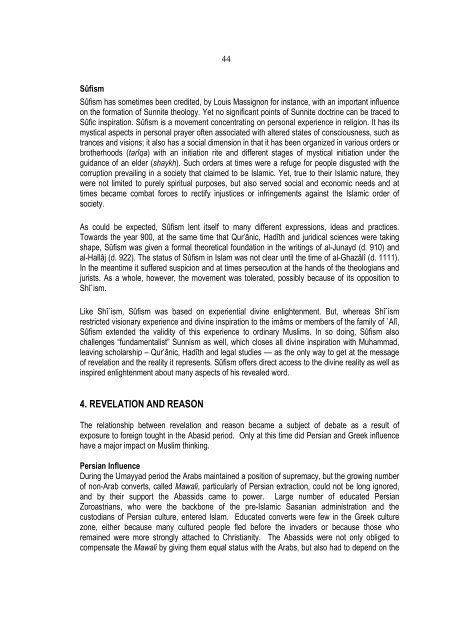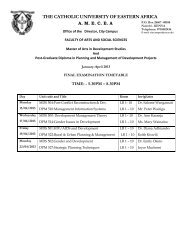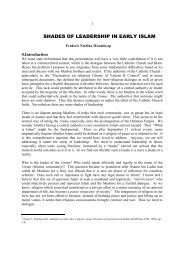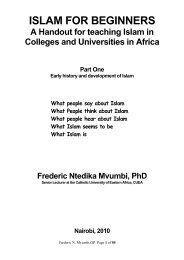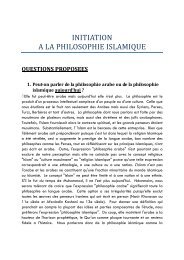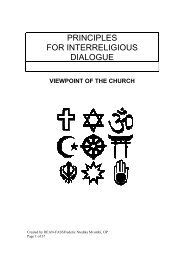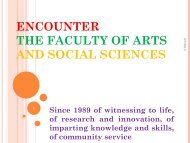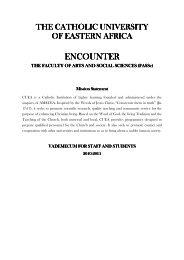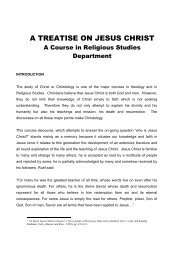INTRODUCTION TO ISLAMIC THEOLOGY.pdf - CUEA
INTRODUCTION TO ISLAMIC THEOLOGY.pdf - CUEA
INTRODUCTION TO ISLAMIC THEOLOGY.pdf - CUEA
Create successful ePaper yourself
Turn your PDF publications into a flip-book with our unique Google optimized e-Paper software.
44SûfismSûfism has sometimes been credited, by Louis Massignon for instance, with an important influenceon the formation of Sunnite theology. Yet no significant points of Sunnite doctrine can be traced toSûfic inspiration. Sûfism is a movement concentrating on personal experience in religion. It has itsmystical aspects in personal prayer often associated with altered states of consciousness, such astrances and visions; it also has a social dimension in that it has been organized in various orders orbrotherhoods (tarîqa) with an initiation rite and different stages of mystical initiation under theguidance of an elder (shaykh). Such orders at times were a refuge for people disgusted with thecorruption prevailing in a society that claimed to be Islamic. Yet, true to their Islamic nature, theywere not limited to purely spiritual purposes, but also served social and economic needs and attimes became combat forces to rectify injustices or infringements against the Islamic order ofsociety.As could be expected, Sûfism lent itself to many different expressions, ideas and practices.Towards the year 900, at the same time that Qur’ânic, Hadîth and juridical sciences were takingshape, Sûfism was given a formal theoretical foundation in the writings of al-Junayd (d. 910) andal-Hallâj (d. 922). The status of Sûfism in Islam was not clear until the time of al-Ghazâlî (d. 1111).In the meantime it suffered suspicion and at times persecution at the hands of the theologians andjurists. As a whole, however, the movement was tolerated, possibly because of its opposition toShî`ism.Like Shî`ism, Sûfism was based on experiential divine enlightenment. But, whereas Shî`ismrestricted visionary experience and divine inspiration to the imâms or members of the family of `Alî,Sûfism extended the validity of this experience to ordinary Muslims. In so doing, Sûfism alsochallenges “fundamentalist” Sunnism as well, which closes all divine inspiration with Muhammad,leaving scholarship – Qur’ânic, Hadîth and legal studies –– as the only way to get at the messageof revelation and the reality it represents. Sûfism offers direct access to the divine reality as well asinspired enlightenment about many aspects of his revealed word.4. REVELATION AND REASONThe relationship between revelation and reason became a subject of debate as a result ofexposure to foreign tought in the Abasid period. Only at this time did Persian and Greek influencehave a major impact on Muslim thinking.Persian InfluenceDuring the Umayyad period the Arabs maintained a position of supremacy, but the growing numberof non-Arab converts, called Mawali, particularly of Persian extraction, could not be long ignored,and by their support the Abassids came to power. Large number of educated PersianZoroastrians, who were the backbone of the pre-Islamic Sasanian administration and thecustodians of Persian culture, entered Islam. Educated converts were few in the Greek culturezone, either because many cultured people fled before the invaders or because those whoremained were more strongly attached to Christianity. The Abassids were not only obliged tocompensate the Mawali by giving them equal status with the Arabs, but also had to depend on the


